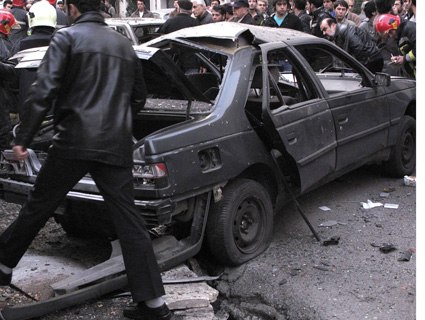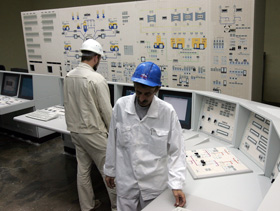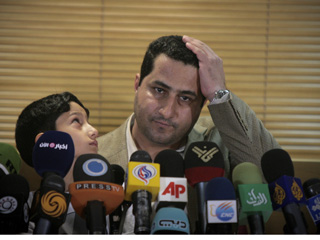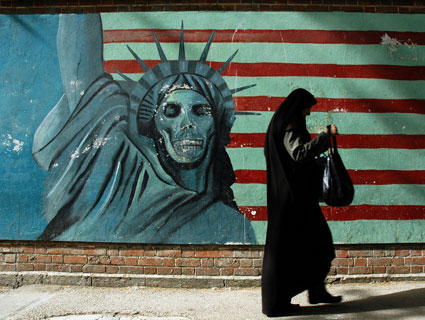
Wreckage from a bomb that killed Iranian nuclear scientist Massoud Ali-Mohammadi in January 2010Eslamirad Mohammad/Zuma Press
Rumors about an imminent military attack on Iran over its nuclear program have come and gone for years. In recent weeks such talk has intensified, though it’s still anybody’s guess as to whether Israel or the United States might openly carry out military action any time soon. But most experts agree on one thing: A covert war with Iran has already been raging for years. Details are often murky, but the conflict has been punctuated with brazen assassinations, exploding missile sites, crippling cyberattacks, and a litany of arrests and spying allegations on all sides. Below is a timeline of major developments in the war—or at least the ones that are publicly known.
Explosions:
- According to an in-depth report in Foreign Policy, Israeli agents, allegedly posing as CIA operatives, recruited members of a Pakistan-based terrorist group called Jundallah, apparently to conduct attacks inside Iran. Over the last decade, the group has repeatedly carried out attacks inside the country, including bombing Iranian mosques in 2009 and 2010.
- An Iranian missile site blows up, killing 17, including Major General Hassan Moqqadam, a Revolutionary Guard commander who was said to be a key figure in Iran’s missile program. Time cites a “Western intelligence official” as saying that Israel was behind the attack. November 2011.
- An explosion occurs in the Iranian city of Isfahan, reportedly near a uranium conversion plant. Iranian officials give conflicting accounts of the cause, then deny that there was an explosion. November 2011.
- An Iranian steel factory in the city of Yazd blows up, killing seven people, some of them reportedly non-Iranians, according to Iranian media. It remains unclear whether the factory had any relation to Iranian nuclear activity. December 2011.
Assassinations:
- Ardeshir Husseinpour, an Iranian nuclear scientist, dies in January 2007. Iran officially says he died from asphyxiation “following a gas leak,” but suspects Israel is behind Husseinpour’s death.
- Massoud Ali-Mohammadi, an Iranian nuclear scientist, is killed by a “remote-controlled bomb” in Tehran. January 2010.
- Unidentified motorcyclists in Tehran attach magnetic bombs to cars carrying Iranian nuclear scientists Majid Shahriari and Fereydoun Abbasi Davani. Shahriari is killed and Abbassi Davani survives the attack. Iranian President Mahmoud Ahmadinejad blames Israel and other “Western governments.” A State Department spokesman claims to have “no information” about the attack; an unnamed US official states that the scientists were “bad people, and the work they do is exactly what you need to design a bomb.” November 2010.
- Iranian state TV interviews Majid Jamali Fash, an Iranian man who claims he worked with Israel to kill an Iranian nuclear scientist in 2010. “My first contact with the Israeli intelligence agency was in Istanbul three years ago,” the man says. “A man named Radfur approached me and suggested I visit the Israeli consulate.” January 2011.
- Darioush Rezaei Nejad, nuclear scientist, is shot dead by a gunman while sitting in a car outside of his home. Nejad becomes the fourth nuclear scientist to have been killed since 2007. An Israeli intelligence official tells Germany’s Der Speigel that Mossad carried out Nejad’s assassination. July 2011.
- In January 2012, Iranian nuclear scientist Mostafa Ahmadi Roshan, is killed by a magnetic car bomb in central Tehran. He is the fifth Iranian nuclear scientist to have been killed in since 2007. January 2012.
- US officials confirm that the Mujahedin El-Khalq, a terrorist group, has been working with Israel to kill Iranian nuclear scientists. The Obama administration reportedly has not been involved, but confirms the US has been aware that the two have been working together. February 2012.
Cyberattacks:
- A computer worm known as Stuxnet infiltrates Iran’s nuclear facilities in mid to late 2009. The worm, reportedly tested in Israel, causes serious damage to Iran’s nuclear centrifuges—20 percent of them are destroyed. The cyberattack is thought to be an Israeli operation, possibly in cooperation with the US or other Western allies.
 Inside Iran’s Bushehr nuclear power plant. PhotoXpress/Zuma Press
Inside Iran’s Bushehr nuclear power plant. PhotoXpress/Zuma Press
- In April 2011, Iran’s civil defense commander claims that a second computer virus, reportedly called “Stars,” has been detected inside Iran. He says of the virus: “Fortunately, our young experts have been able to discover this virus and the Stars virus is now in the laboratory for more investigations.”
- In September 2011, a third computer virus is reported to have disturbed the Iranian nuclear program. Symantec, a company that develops security software, says the virus is a “precursor to a future Stuxnet-like attack.” Iranian officials say the virus did not impact the nuclear program.
Disappearances:
- Ali-Reza Asgari, a high-ranking official in former Iranian President Mohammed Khatami’s administration, goes missing in Turkey in 2006. Asgari’s disappearance gives rise to speculation that he’d been kidnapped or had defected, and had ended up in Israel. His whereabouts remain unclear.
- Robert Levinson, a retired FBI agent, goes missing on the Iranian island of Kish in 2007. He reportedly was there to investigate cigarette smuggling on behalf of a private client. Four years later, a video surfaces of Levinson, in which he pleads for the US to help him. It’s unclear who is holding Levinson.
Plane crashes:
- Over a year and a half, three Revolutionary Guard airplanes go down in Iran on three separate occasions; one crash kills the Guard’s ground forces commander. Spokespeople for the Revolutionary Guard say that the planes’ engines “failed.” 2006-2007
- A highly sophisticated US military drone, launched from a base in Afganistan, goes down in Iran. The Iranian government claims to have brought it down—offering conflicting accounts about shooting it down and taking control of it via cyberattack. It says the drone has “priceless technological information,” and later shows it off on state television. December 2011.
Arrests and spying allegations
- Shahrazad Mir Gholikhan, an Iranian woman, is arrested, charged, and sentenced to more than five years for allegedly attempting to export 3,000 “helmet-mounted Generation III U.S. military night vision goggles” from the US to Iran. November 2004.
- Amir Hossein Ardebili, an Iranian man, is sentenced to five years for violating US exporting laws. According to US officials cited by CNN, Aredbili “had requested missile and aircraft parts and night vision equipment” to take back to Iran. December 2009.
- In a sting operation, US authorities arrest four Columbian citizens and charge them with attempting to export F-5 fighter jet engines to Iran. Their relationship to Iranian officials remains unknown. March 2011.
 Iranian defector Shahram Amiri. Ahmad Halabisaz/Zuma Press
Iranian defector Shahram Amiri. Ahmad Halabisaz/Zuma Press - Shahram Amiri, an Iranian nuclear scientist who had defected to the US, returns to Iran in July 2010. After his return, a US official tells CNN that Amiri had been given $5 million for “information.” Hillary Clinton states publicly: “Let me say that Mr. Amiri has been in the United States of his own free will.” Amiri reportedly is arrested in Iran seven months later. March 2011.
- US officials allege that the Iranian government ordered the assassination of the Saudi ambassador to the US. They say that Manssor Arbabsiar, a former used car salesman in Texas, attempted to work with a Mexican drug cartel to conduct the hit. Iran denies the charges. October 2011.
- Iran says it has arrested 12 CIA agents. An Iranian official says of the agents’ plot: “The main mission of this act of espionage was related to Iran’s progress in the fields of nuclear technology and also military and security activities.” November 2011.
- Mojtaba Atarodi, an Iranian scientist and professor at Tehran’s Sharif University, is arrested in Los Angeles for violating export laws in relation to his purchase of high-tech US lab equipment. An official from Sharif university says Atarodi is “just a professor, and he was trying to buy some equipment for his lab” back in Iran. January 2012.
- Amir Hekmati, a US citizen and former Marine, is arrested in Iran and sentenced to death for allegedly being a CIA agent. Hekmati admits to becoming a CIA agent on Iranian state media, but his family believes he has made the confession under duress. January 2012.














